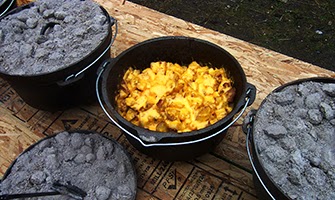I don’t do it terribly well or
profess any real mastery of it’s cosmically subtle nuances; but I do enjoy the vibrant
miracles that result from my feeble efforts and marvel that such a pioneer process,
so simple in concept and process, produces such incredibly tasty rewards.
Dutch ovens are those 5 to 15 dollar
cast iron pots you quite often see under tables at garage sales, or hanging much
more expensively in antique stores. You can also purchase them at outdoor recreational outlets or online. They are fairly heavy, will usually be of
sufficient size to handle a small chicken or large roast, and traditionally
have three cast iron legs protruding from their typically rusted underbellies.
Covering the top is a matching cast iron lid sporting a decent one inch ridge
rising upward from its rounded rim.
The one inch legs on the oven
were originally designed to keep the pot sitting above the charcoaled nuggets set
ablaze beneath it. The ridged top edge serves to contain more hot embers,
permitting additional heat from above. The resulting top and bottom, slow roast
effect of the iron clad combination, either performed in dug out ground-pits,
on surfaced fire places, or even in conventional home electric ovens, is absolutely
amazing.
However, the repeated hoisting and repositioning of several of these pre-microwave beasties during a cookout is not for the weak or
faint-hearted. I have in my stronger days, cooked for upwards of 200 people
during one countrified camping scenario or another, and by the end of the workout,
have fully enjoyed the analgesic attributes of Robaxacet or some equally
successful muscle relaxant. You see, it takes considerable
effort shuffling the various sized pots about for two to three hours whilst
ensuring adequate heat advantage for each of the internalized simmering delights.
During pioneer times, women and men were frequent users of such heavy hardware,
but with the advent of modern culinary capers it is easy to understand why these muscle
builders have almost gone the way of the Dodo.
And yet, in hopes of forwarding promotion
to revive this ancient and almost lost art, I must proselytize that one small pot
is quite easily maneuvered. Comfortably, and with little more effort than that
used for an electric slow cooker, a Dutch oven can help you relive the
colonization history of our forbearers and provide a sumptuous and highly
flavorful feast, while permitting you to skip completely the serious hardships
of the pioneering experience.
My peculiar favorite recipe is “Wild Turkey Surprise”, a concocted
title fearlessly gleaned from a Bugs Bunny cartoon of the late 1950’s. The merrymaking begins
by sautéing approximately ½ lb of chopped bacon in a preheated, 350 degree
pot (use a conventional oven if you have one) followed by a healthy portion of
finely diced onion (1 cup at least). These two are baked in the Dutch oven itself until
the ingredients are decently cooked. How long is up to you, but around 10-15
minutes is usually sufficient.
Then, previously secret-spiced, browned,
and reasonably large, tennis ball sized meat rounds - made up of equal portions of finely
ground hamburger, veal, and pork, each now center-stuffed with a large chunk of
mozzarella cheese - are placed lovingly inside the Dutch oven and amply rolled
about within the bacon and onion mixture. Just how many of the delectable orbs you create depends on
the size of the pot, the number of Tasmanian Devils you are cooking for, and how desperately hungry you may be, once you are as hooked on the art
form as I am.
The wonderfully aromatic, but certainly not
calorie conscious concoction is then returned to the coals (or conventional
oven) for browning, and then as long as it takes to permit the next bit of culinary magic to
happen (approximately 30-40 mins.)
At this juncture, the Dutch oven is
filled with your favorite spaghetti sauce recipe,
stirred gently so as to fully engage all the ingredients, and then popped back on
the coals to be simmered at a lower, on the bottom fringe of bubbling,
temperature. The stirring should be repeated at 10-15 minute intervals, or
whenever you remember.
After an hour or two of this
steeping procedure, and appropriate taste testing, the meatballs and sauce may
be amply served onto either prepared spaghetti noodles, or as my family used to prefer,
garlicked, mozzarella cheese-toasted, hoagie halves (two each, naturally).
Warning: This meal should probably only be
consumed on rare occasions, simply to prevent a coronary, or increased
hardening of the arteries… but it is very, very tasty! The process is loads of
fun and the mystery of how well it works is really quite captivating. The
surprise, if you haven’t guessed it already, at least in this particular recipe,
is that there isn’t any turkey at all. Nothing is wild, and by the last
forkful, nobody even cares!
And so, until the next
thought bubble decides to burst… here’s wishing you the best of everything the good
world has to offer. – J.
Article Copyright J. Michael Lyffe - 2014



No comments :
Post a Comment